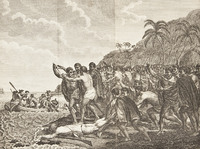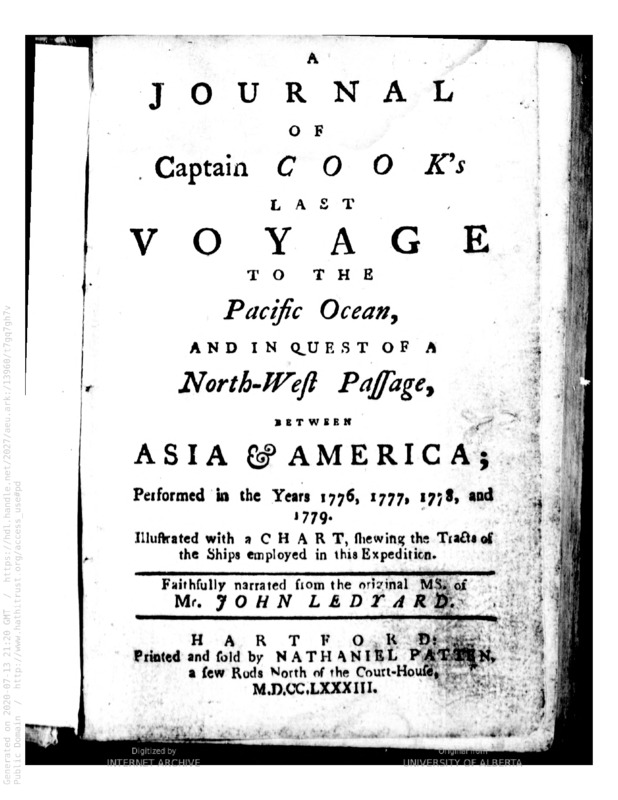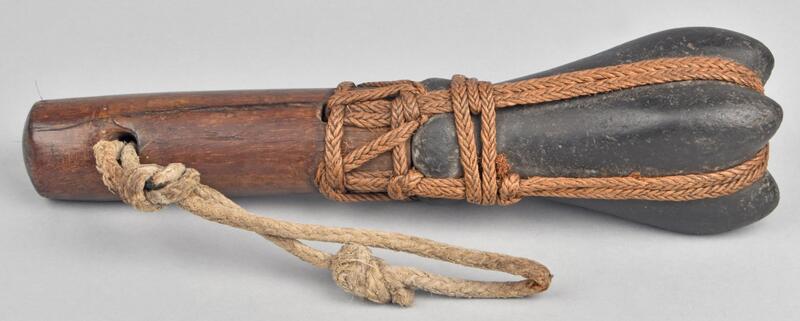A Journal of Captain Cook's Last Voyage
Cook’s first two voyages had been sponsored by the Royal Society and the Admiralty. The first expedition he commanded had the secondary mission of observing the transit of Venus from Tahiti, recently discovered by Wallis. His primary mission was seeking the “Great Southern Continent,” and claiming it for England. On both his first and second voyages scientific discovery was as important as the exploration, seeking faster routes to the Far East.
Ledyard signed on his third voyage, which was about trade and imperial design, to continue his surveys of the South Pacific, but critically, to seek the fabled Northwest Passage.[1] Of equal import was continuing to establish a British presence in New Albion, the Northwest Pacific coast of America. The western coast was claimed by Spain, Britain and Russia, and the first Americans to see it from the sea were the six sailing with Cook, in March of 1778.[2]
While Cook avoided Spanish settlement, he did encounter a Russian trading post. After an encounter with Native Americans where he was offered a peppered dish, Cook sent Ledyard with them to determine the source; Ledyard returned with Russian fur traders. After several months of charting the coast and correcting charts provided, Cook returned to the South Pacific to winter, a fatal choice for him. His death was not the end of the voyage, as the ships returned north and continued surveying and collecting sea otter pelts. The port call in Canton on the voyage home would demonstrate the value of these animals, and become a central theme in Ledyard’s life – commercial applications of his knowledge of the Pacific Northwest and sea otter fur trade and crossing the North American continent.
Ledyard’s A Journal of Captain Cook’s Last Voyage to the Pacific Ocean and in Quest for A North-west Passage between Asia and America Performed in the Years 1776, 1777, 1778 and 1779 was one of the first books to be published in the United States protected by a copyright. Ironically, the journal was likely in part plagiarized from a similar, anonymous journal later attributed to an officer on HMS Resolution. [3]
The journal was in many ways a straightforward business proposition. Several sailors had considered mutiny or desertion in order to return to Nootka Sound (also known as King George’s Sound) on Vancouver Island to continue the profitable trade. Ledyard understood the potential of the fur trade, driving him to multiple attempts to secure financing to return to the Northwest and set up factories to harvest the pelts and carry them on to China. The factory scheme was not completely impractical, as the British would do just that within ten years, with the ships crewed by two officers from Cook’s voyage.[4]
Ledyard’s book was criticized for his later use of unattributed other works as well as having an anti-British bias. Several incidents of Cook’s interactions with the native peoples are criticized, including the one leading to his death in Hawaii in 1779. The debate over Cook’s death and lessons learned from his treatment of indigenous peoples is reflected in Ledyard’s work on the voyage as well as how he observed the various Russian populations he encountered. Captain James Billings, who sailed with Cook as well and later hosted Ledyard in Irkutsk and Yakutsk, also made a point of trying to deal with native peoples from a place of respect instead of assumed superiority.[5]
Ledyard also understood the other ramifications of the search for the Northwest Passage. The voyages and charting of the Pacific Northwest was a key part of delineating empires, and an increasingly opportunity for the new United States to increase and define its territory.
[1] Captain James Cook, Voyages of Discovery, Chicago Review Press, 2005. ProQuest Ebook Central, https://ebookcentral-proquest-com.mutex.gmu.edu/lib/gmu/detail.action?docID=1717189, pp. v-vii.
[2] Cook, p. 243.
[3] James Zug. American Traveler: The Life and Adventures of John Ledyard, The Man Who Dreamed of Walking the World. New York: Basic Books, 2005. Kindle edition.Locations 1638, 1656, 1700.
[4] Gray, p.123
[5] Ryan Jones (2006) Sea otters and savages in the Russian Empire: The Billings Expedition, 1785–1793, Journal for Maritime Research, 8:1, 106-121, DOI: 10.1080/21533369.2006.9668358, p. 112


